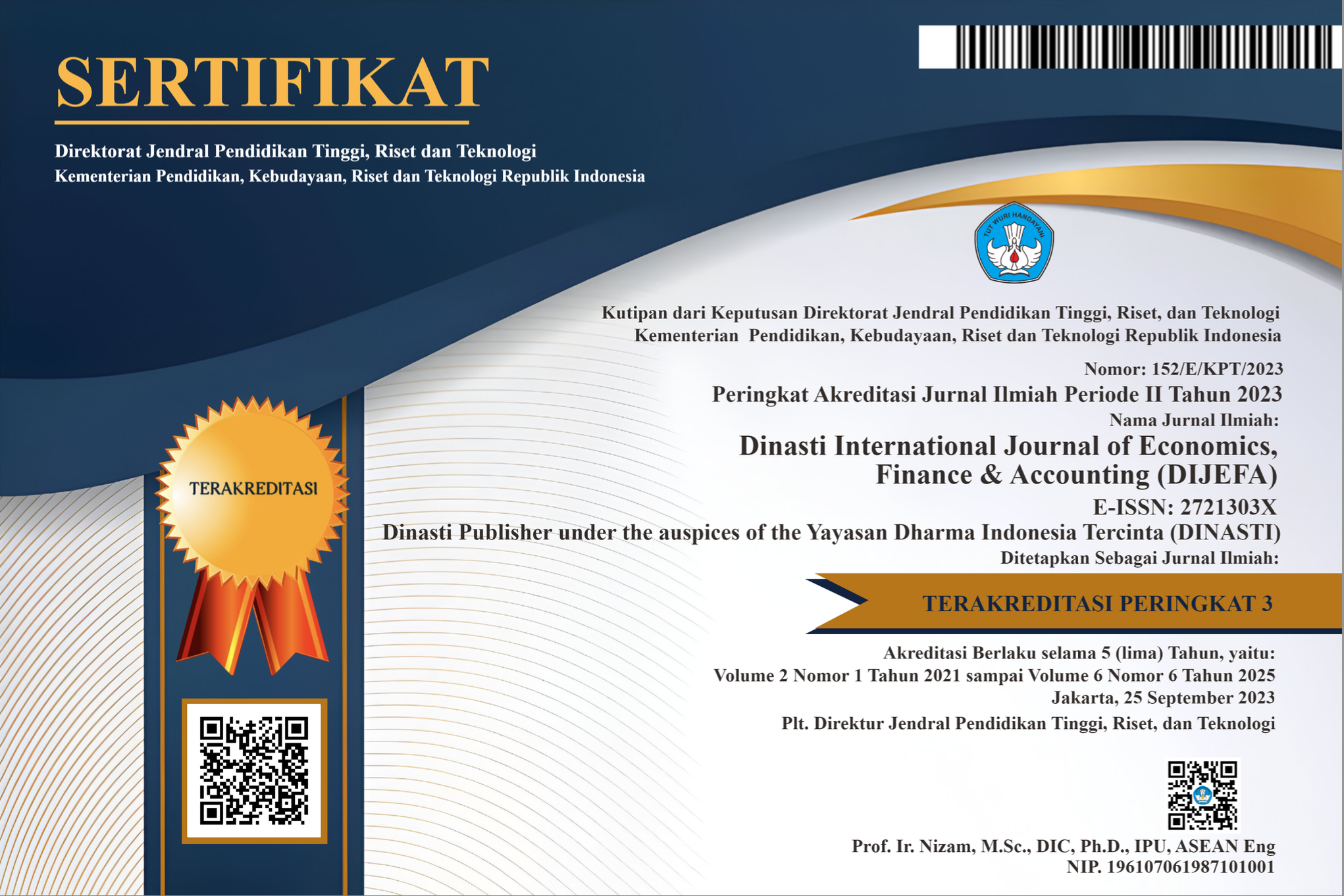ANALYSIS OF WORKING CAPITAL AND FINANCIAL PERFORMANCE OF SHARIA BANKING INDUSTRY INMANDIRI SYARIAH BANK JAMBI
DOI:
https://doi.org/10.38035/dijefa.v1i5.609Keywords:
Working capital, Liquidity Ratio, Profitability RatioAbstract
The purpose of this study is to find out working capital in an independent Islamic bank, the financial performance of an independent Islamic bank in Jambi by using a liquidity ratio analysis tool (current ratio, cash ratio) and profitability ratio (profit margin) and there is also a significant relationship between current ratio cash ratios and profit margins with working capital at the Islamic bank Mandiri jambi. The analytical tool used is multiple linear regression. Study the significant relationship between current ratio (X1), cash ratio (X2) profit margin (X3) as the independent variable and working capital as the dependent variable. The results of working capital analysis at the jambi independent Islamic bank have fixed assets and current assets with a total average current assets from 2016 to 2019 of Rp 88,919,015.5 and for average fixed assets from 2016 to 2019 of IDR 856,841.06. Analysis results Financial performance through liquidity ratios namely current ratio and cash ratio obtained an average current ratio from 2016 to 2019 of 115.67%, and obtained an average cash ratio from 2016 to 2019 of 1.55%. For profitability ratios namely profit margins can be obtained an average profit margin from 2016 to 2019 of 72.82% with very good criteria because it exceeds the maximum limit of the standard ratio. The test results on the relationship of the current ratio, cash ratio and profit margin with working capital obtained a person correlation current ratio of 1,000 means perfect correlation and there is a relationship between the current ratio with working capital. For cash ratio with a person correlation value of cash ratio of 1,000 means perfect correlation and there is a relationship between cash ratio and working capital. For the value of person correlation margin of 1,000 means that it means perfect correlation and there is a relationship between profit margin and working capital. It can be concluded that working capital influences the current ratio, cash ratio and profit margin.
References
Jumingan. (2006). Pengukuran Kinerja Keuangan. Jakarta: PT. Bumi Aksara.
Kasmir. (2012). Manajemen Modal Kerja. Jakarta: PT. Raja Grafindo Persada.
Kasmir. (2012). Modal Kerja. Jakarta: PT Raja Grafindo Persada.
Munawir. (2010). Modal Kerja. Bandung: CV Alfabeta.
Munawir. (2012). Kinerja Keuangan. Yogyakarta: Liberty.
Muslich, M. (2005). manajemen keuangan. Jakarta: Bumi Aksara.
Nuriasari, S. (2018). Riset Bisnis dan Investasi. Analisa Rasio Likuiditas Dalam Mengukur Kinerja Keuangan PT. Mustika Ratu, Tbk (Tahun 2010-2016), 4(2), 1-9. Retrieved from https://jurnal.polban.ac.id/ojs-3.1.2/an/article/view/1181
Rijal, A. (2018). keuangan dan perbankan syariah. EFEKTIFITAS MODAL KERJA DAN LIKUIDITAS SERTA DAMPAKNYA PADA KEBIJAKAN DIVIDEN PERUSAHAAN BERBASIS SYARIAH , 1-17.
Sumantri. (2019). Manajemen Keuangan (Cetakan Pertama: Januari 2019 ed.). (M. Nasrudin, Ed.) Jambi, Jambi, Jambi: PT. Nasya Expanding Management (Anggota IKAPI).
Chandra, R. (2016). kinerja keuangan. ANALISIS KINERJA KEUANGAN PT BANK SYARIAH MANDIRI DAN PT BANK MANDIRI TBK DENGAN MENGGUNAKAN METODE CAMEL, 429-13.
Anwar, S., & Ali, A. . H. (2018). ANNs-Based Early Warning System for Indonesian Islamic Banks. Buletin Ekonomi Moneter Dan Perbankan, 20(3), 325–342. https://doi.org/10.21098/bemp.v20i3.856
Firdaus, M. F., & Hosen, M. N. (2014). Efficiency of Islamic Banks Using Two Stage Approach of Data Envelopment Analysis. Buletin Ekonomi Moneter Dan Perbankan, 16(2), 155–176. https://doi.org/10.21098/bemp.v16i2.442
Irawan, D., & Kacaribu, F. (2017). Tri-Cycles Analysis on Bank Performance: Panel Var Approach. Buletin Ekonomi Moneter Dan Perbankan, 19(4), 403–442. https://doi.org/10.21098/bemp.v19i4.694
Narayan, P., & Reddy, Y. V. (2018). Impact of financial performance indicators on stock returns: Evidence from India. International Journal of Business and Society, 19(3), 762–780.
Nawaz, T. (2017). Intellectual capital, financial crisis and performance of Islamic banks: Does Shariah governance matter? International Journal of Business and Society, 18(1), 211–226. https://doi.org/10.33736/ijbs.497.2017
Sumantri. (2019). Manajemen Keuangan Pekalongan-Indonesia (Moh. Nasrudin (ed.); 1st ed.). PENERBIT NEM PT. Nasya Expanding Management (Anggota IKAPI). www.penerbitnem.com
Sumantri. (2020). Pengaruh Produk Bank Syariah Mandiri Terhadap Minat Menabung Masyarakat Kecamatan Muara Tembesi Kabupaten B. CITRA EKONOMI, 1(1).
Sumarta, N. H., & HM, D. Y. (2003). Evaluasi Kinerja Perusahaan Perbankan Yang Terdaftar Di Bursa Efek Indonesia Dan Thailand. Buletin Ekonomi Moneter Dan Perbankan, 3(2), 183–203. https://doi.org/10.21098/bemp.v3i2.293
Taiwo, J., Ucheaga, E., Achugamonu, B., Adetiloye, K., Okoye, L., & Agwu, M. (2017). Credit Risk Management: Implications on Bank Performance and Lending Growth. Saudi Journal of Business and Management Studies, 2(5B), 584–590. https://doi.org/10.21276/sjbms
Trinugroho, I., Risfandy, T., Ariefianto, M. D., Prabowo, M. A., Purnomo, H., & Purwaningsih, Y. (2017). Does religiosity matter for Islamic banks’ performance? Evidence from Indonesia. International Journal of Economics and Management, 11(2), 419–435.
Hasibuan, M. (2011). Manajemen. Jakarta: Bumi Aksara.
Kusumo, Y. A. (2008). kinerja keuangan. Analisis Kinerja Keuangan Bank Syariah Mandiri Periode 2002 – 2007 (dengan Pendekatan PBI No. 9/1/PBI/2007), 109-131.
Sukarno. (2011). Analisis Kinerja Keuagan dan Pengukuran Tingkat Kesehatan PT. Bank DKI periode 2007-2009 dengan Menggunakan rasio Keuangan Bank dan Metode Camels. Ekono Insentif Konwil4, Vol.5 No 2, Oktober 2011. ISSN: 1907-0640, 1-8.
Sugiyono. (2013). Metode Penelitian Kuantitatif dan Kualitatif dan R&D. BANDUNG: CV Bandung.
Downloads
Published
How to Cite
Issue
Section
License
Authors who publish their manuscripts in this journal agree to the following conditions:
- The copyright on each article belongs to the author(s).
- The author acknowledges that the Dinasti International Journal of Economics, Finance & Accounting (DIJEFA) has the right to be the first to publish with a Creative Commons Attribution 4.0 International license (Attribution 4.0 International (CC BY 4.0).
- Authors can submit articles separately, arrange for the non-exclusive distribution of manuscripts that have been published in this journal into other versions (e.g., sent to the author's institutional repository, publication into books, etc.), by acknowledging that the manuscript has been published for the first time in the Dinasti International Journal of Economics, Finance & Accounting (DIJEFA).


























































